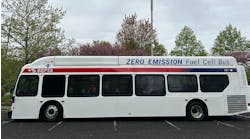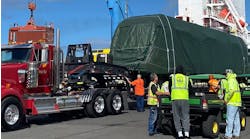Plans for bullet-train stations in Fresno and the San Joaquin Valley are providing local leaders and would-be passengers a glimpse of what the facilities could look like by 2030, when the California High-Speed Rail Authority hopes to begin carrying riders on its 171-mile initial operating line between Merced and Bakersfield.
Each of the rail agency’s four stations – in downtown Merced, Fresno and Bakersfield and on the outskirts of Hanford – will include common structural, architectural and visual components from what Margaret Cederoth, the authority’s director of planning, described as a “kit of parts.”
But at each station, those parts will be configured in different ways depending on the idiosyncrasies of the location.
In downtown Fresno, for example, plans call for a covered pedestrian bridge connecting entry plazas along Mariposa Street on each side of the station, spanning not only the existing Union Pacific Railroad freight tracks and the future high-speed rail tracks, but also G Street on the west side of the station. A concourse including fare gates will be on the upper level of the station, with the train tracks and boarding platforms at ground level.
Stations in Merced, Hanford and Bakersfield, however, will feature viaducts on which elevated tracks and boarding platforms will sit, with entry plazas and concourses at ground level. Merced’s station in particular is being designed as a hub for multiple passenger rail services: high-speed rail, the existing Amtrak San Joaquin service, and a future southern terminus for the Stockton-based ACE Rail trains.
A fifth station at the northern edge of Madera will be shared with Amtrak and is being developed through a separate process by the San Joaquin Rail Authority, which oversees the Amtrak San Joaquin trains that run through the Valley.
Up and down the line, city leaders are counting on the stations to serve not only as transportation sits, but also as an impetus for economic growth.
“I know (high-speed rail) is going to be a game-changer for the Valley and for Fresno,” Fresno Mayor Jerry Dyer told the rail authority’s board via Zoom at its Feb. 29 meeting in Sacramento. “I’m thankful we’re going to have the first high-speed rail station in the nation here in downtown Fresno.”
Similarly, Merced leaders are eager for the station in their downtown. “We are a multi-modal station, where we have three trains coming into one location,” said Frank Quintero, Merced’s deputy city manager, “and we see it as a major economic catalyst.”
Merced’s station along 15th Street between O and R streets will not only serve passengers on the future bullet-train line, but also the existing Amtrak San Joaquin passenger trains as well as a future southern terminus of the Stockton-based ACE Rail commuter train service.
But Quintero said there remains much work to be done. “We are concerned about pedestrian access,” he said. He spoke of growth in the central part of downtown and noted that “bridges and really good access to the site” will be important considerations for the flow of foot traffic to and through the station. “Where do they go? How do they get there? These are all things I know we’ll be working on” with the rail authority’s staff.
See Lee, CEO of the Boys & Girls Club of Merced County, said the club’s operations at the McCombs Youth Center are only one block from the future rail station. “For the last 20 years we have provided programs and services at this location,” Lee told the board via Zoom. “And as we are excited and in support of the high-speed rail, as well as the expansion of ACE and Amtrak, we hope we can get your support in relocating our facility to continue serving our young people in the next generation to come.”
In Merced, boarding platforms and tracks for high-speed rail and Amtrak trains will be located on the upper level of the station, while ACE trains will be served at ground level, next to the existing Union Pacific Railroad freight tracks.
An area of Bakersfield north of downtown also could undergo a metamorphosis, said that city’s mayor, Karen Goh. “Our city envisions the station and surrounding area as a destination and an economic hub with retail, restaurants, office space and housing,” Goh told the rail board.
The elevated Bakersfield station will extend about 4,000 feet atop a 60-foot-high viaduct, providing opportunities for a shaded recreational area and possible space for vendors, Cederoth said. “This station will really be an anchor for a new node of development” near the city’s downtown. “This is where they want to grow up taller with a mix of uses.”
Goh said the city’s planning efforts for the station “have been driven by community engagement with residents who have longed for the transformation of our downtown into a multi-modal corridor that will revitalize our community.
In Hanford, where a station is intended to serve the population of Kings and Tulare counties, deputy city manager Jason Waters said the city “is in the early stages of determining the types of land use that will make sense around the station area” at the eastern fringe of the city north of Highway 198. “I am happy to see the design and scope of the Kings-Tulare station is beginning to materialize because that will make coordination (between the city and the rail authority) much easier.”
Fresno mayor voices concern
While Dyer expressed his support for the high-speed rail project, he also voiced concern about aspects of the station design. “It’s been brought to my attention that the design of the high-speed rail station tentatively is not set to extend over into the Chinatown area in terms of the pedestrian bridge,” he said on Feb. 29. “I think that is critical in reconnecting a community that oftentimes has been forgotten and left behind.”
He also stressed the importance of ensuring that there is shade that protects the pedestrian bridge from the Valley’s summer sun.
Small-scale station models and renderings on display at the Sacramento meeting, however, show that the pedestrian bridge is indeed to be covered by a canopy and descend into a Chinatown plaza on the west side of G Street. “That’s something that we’re analyzing with the community now,” Cederoth told The Fresno Bee. “There’s some functional elements to it, and we want to think very carefully about the power supply to (the plaza), because it’s meant to be a high-capacity, zero-emission vehicle mobility hub.”
In her presentation to the authority board, Cederoth said she appreciated Dyer’s comments. The station and plaza design, she said, considers “the importance of the station having two sides, equal and equitable investments in Chinatown and in downtown, so those passenger facilities are on both sides of the track and that investment helps to reinforce the local economy and the surrounding neighborhoods.”
And she pointed out that the bridge will be covered “because we respect that it’s incredibly hot in Fresno, Bakersfield, ( Hanford) and Merced.”
Cederoth said design work on renovations to the historic Southern Pacific railroad depot at H and Tulare streets on the Fresno station site is going hand-in-hand with plans for entry plazas that are expected to be built and opened for public use in 2027, prior to construction on the station itself starting in 2028.
Tom Richards, a Fresno developer who is the chairman of the rail authority board, described the Fresno station as “the rebirth of downtown Fresno.”
“This is viewed as being clearly the place to be, which is something that hasn’t been in Fresno for over half a century,” he said. “It is a hope, it is a belief, it is a revitalization. It’s a redirection of economic development in our state as a whole.”
A long waiting game
“You cannot believe how anxious and anticipatory the people in the Valley are for this (project) to happen” Richards added. “The thing that has become clear is there’s less concern about it not happening. The concern is, how fast can we make it happen, because people have been waiting for a long time.”
How long? California voters passed Proposition 1-A, a $9.9 billion bond measure to support development of a statewide high-speed rail system, in November 2008.
In 2010, the U.S. Department of Transportation pledged the first of several installments of federal grants to help pay for planning and construction of the project in the San Joaquin Valley. The first construction contract for work in the Valley was awarded in 2013, and a formal groundbreaking in Fresno was held in early 2015.
The vision at that time was for a statewide, electrified system of trains carrying passengers between San Francisco and Los Angeles at speeds up to 220 mph. That remains the long-range plan, but financial realities in recent years forced California Gov. Gavin Newsom to scale back short-term efforts to focus on completing an initial operating segment from Merced to Bakersfield.
The rail authority has also contributed to railroad improvements in the Los Angeles area in anticipation of future operations there, as well as electrifying the Caltrain commuter rail service on the San Francisco Peninsula so those tracks can be shared with future high-speed trains.
©2024 The Sacramento Bee. Visit sacbee.com. Distributed by Tribune Content Agency, LLC.



